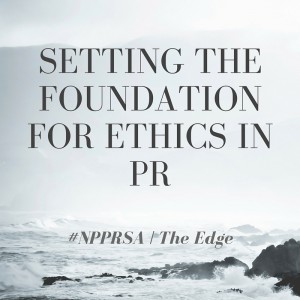That sentence, uttered in one of the first classes of the year by my favorite journalism professor, is one of the ethical guides I follow through my career. The other is the PRSA Code of Ethics.
As new professionals, navigating the working world is complicated. PR professionals, new and old, are also responsible for maintaining a certain level of ethical behavior while in the public eye. Professionals across most industries are also expected to be honest and to observe ethical practices, but not many other industries are active in the public eye more often than they’re not.
Instead of the traditional methods of relaying messages through media, PR pros use more direct methods like social media, blogging, guest and sponsored posts, and other self-publishing options. Each method has pros and cons, but the ethics of how we present information and interact with our audiences are things we should also to factor into daily decisions.
Every year, PRSA celebrates Ethics Month in September and this year’s theme was “Ethics Every Day,” making the point that ethics are part of even the most routine, mundane decisions.
According to Kirk Hazlett, member of PRSA’s Board of Ethics and Professional Standards, in his piece in September’s issue of “Public Relations Tactics,” “Ethics should be an everyday reality for all of us. It should be intuitive, not haphazard and reactive.”
Too often, we look at decisions through an ethical lens only after damage has already been done. Companies, like Volkswagen, for a current example, only seem to think about the repercussions of the decisions, usually made by executives, after the shady practices are uncovered and made public. But those are only things that happen to big companies and famous people – unknown PR pros don’t have these sort of far-reaching important ethical dilemmas come across their desks, right?
Wrong. Everyone encounters decisions with ethical complications every day. Most of them are pretty simple decisions, like misrepresenting yourself, your company or your client, adding undisclosed fees to a contract, breaching client confidentiality or concealing information, that we might make without even thinking about the unethical alternative.
“It is part of everything you do as a public relations professional,” Hazlett said. “You can’t forget that people are looking to you for the truth…[Being an ethical practitioner] is not something you take off at night.”
The Code of Ethics lays out 12 ethical elements that decisions fall into and that are important to public relations. These include six values: advocacy, honesty, expertise, independence, loyalty, fairness, and six core principles: free flow of information, competition, disclosure of information, safeguard confidences, conflicts of interest and enhancing the profession. According to PRSA, “these values are the fundamental beliefs that guide our behaviors and decision-making process. We believe our professional values are vital to the integrity of the profession as a whole.”
A good tool to use to understand how these ethical elements fit into our everyday professional lives is the matrix of ethical dilemmas. The matrix outlines common dilemmas that occur within business conduct, general management, products, process, and client, competitor, government, employee, outsider and vendor relations, and matches them to the corresponding ethical category(ies).
Understanding ethical dilemmas is only part of our responsibility, though. Once we understand that these commonplace decisions do have ethical consequences, we have to know why these ethics are important and how to handle it when they are challenged in the workplace. As PR practitioners, the public depends on us to provide them with information and to be honest and truthful in our actions. Hazlett believes that the more honest a PR pro is, the more effective their organization’s methods and messages will be.
“[Being honest] is the one thing that opens the conversation and lends credibility to what we’re saying,” Hazlett said. “If I’m viewed as being an ethical person…it makes it easier for us to get our messages out. Ethics has to be there. You can’t be viewed as someone who will only tell the truth when it’s convenient.”
According to Jason Mollica, president of JRMComm and member of PRSA, pressure from a supervisor is a common dilemma faced by professionals of all levels.
“I think one of the most common struggles is feeling as if you HAVE TO follow the directive, even if it is something that is not right,” he said in an email interview. “New pros (or pros in general) should never be put in a position where they need to bypass their ethics to satisfy a superior or client.”
Mollica added that whenever practitioners are struggling with a decision or need a bit of guidance, there are plenty of resources for them to seek out. Professionals should always take the time to step back and really think about their decisions before making them. Consulting the Code of Ethics can help us to remember the importance of being an ethical practitioner and reaching out to colleagues, mentors or members of the Board of Ethics and Professional Standards can also be helpful in resolving difficult situations.
The most important thing we can do, though, is to simply commit to being an ethical practitioner and speak up against the things we feel are unethical practices.
 Robyn Rudish-Laning is a member of PRSA SC and communications coordinator for the South Carolina Council on Competitiveness. She is a graduate of Duquesne University and is currently located in Columbia, SC. Find her on LinkedIn or Twitter or read her PR-focused blog.
Robyn Rudish-Laning is a member of PRSA SC and communications coordinator for the South Carolina Council on Competitiveness. She is a graduate of Duquesne University and is currently located in Columbia, SC. Find her on LinkedIn or Twitter or read her PR-focused blog.






